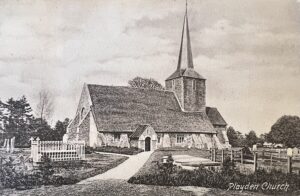In about 1200 a hospital dedicated to St. Bartholomew was established in Playden, although it was more generally described just as being “outside Rye”. The first reference to the hospital was a statement by a priest called Simon and others, that Abbot Ralf of Fecamp had given all the lands, buildings and chapel for the hospital “in perpetual alms, saving an annual payment of two shillings to the abbot and convent, who are to have the appointment of future priests upon the nomination of the officers of the town of Rye”. The abbey was also to have a share of the takings if the king allowed a fair to be held on St. Bartholomew’s Day. No record of a royal grant of a fair has survived, but for many years such a fair was held in the grounds of the hospital.
We know how the hospital was run thanks to a 16th century document called The Custumal of Rye, described as: “Theis byn the Vsagis of the Comynaltye of the Towne of Rye vsed ther of tyme out of mynde which mens myndes cannot thinck the contrarye.” This tells the researcher that the mayor and jurats would nominate the warden or chaplain and give his name to the Abbot of Fecamp. If England happened to be in one of its regular wars with France at the time a nomination was due, then the Lord Chancellor received the name, which was then passed on to the Bishop of Chichester, is whose diocese Rye still remains.
There was no set number for the people, of either sex, that the hospital could take in, but the mayor and commonalty had to give their approval for each admittance. The mayor and commonalty had the right to have people admitted, “man or woman which had competently borne charges in their time for the welfare of the town, if they be now impoverished and impotent, decayed of their goods and chattels, and little goods to live with.” In addition, the mayor and jurats of Rye had custody of the hospital seal, so that none in there could dispose of land or property without proper consent. This requirement seems to have been introduced when the Barons of Rye included it in a charter in 1249. The charter tells that there were 12 men and women in residence, some of whom had the terrible affliction of leprosy, then common in England. (The last person who contracted leprosy in this country died in 1798.)

The hospital warden was supposed to be a spiritual shepherd to his little flock, and act for their good. Sadly, this wasn’t always the case. In 1262, Randell de Wyke, who had been appointed in 1344, asked Sybil of Yarmouth to burn barns and hayricks in Beckley, the property of Mathew de Knoll. After her arrest, Randell helped her to escape custody and hid her in the hospital. She then took sanctuary in the village church where she formally abdured the Realm – that is swore to leave the country immediately and never return. The connection with Yarmouth is interesting; there was a long-standing feud between the Portsmen of Rye and Yarmouth.
The hospital seems to have been a regular barrel of bad apples. In 1380, Robert de Burton was investigated by two commissioners, William Horne and William de Battesford. He was adjudged to chopped down trees worth £20 in Brookland, had “wasted and appropriated to his own use grain to the value of £10 and had allowed the hospital lands to go out of cultivation”. As if that wasn’t enough, he was accused of taking for his own use muniments, bills and indulgences (Papal grants for the remission of punishment for sins in purgatory after absolution,) so all items worth money – some £2 a year – and spent the money on his own gratification, meaning that the hospital residents had to go out begging for food and money on the streets of Rye. Even that hadn’t satisfied Robert’s greed. He hadn’t been paying the rent, so bailiffs took all the brass pots from the kitchen, meaning there was nothing in which any food could be cooked.
We might hope that after this disastrous episode matters improved, but they didn’t. The Bishop of Chichester, Richard Praty, a particularly conscientious man, who worked hard to maintain high standards in his diocese, paid a visit to the hospital in January 1442. He found that buildings, including the chapel, were becoming ruinous, no one was resident and the Master, William Parker, hadn’t been seen for nearly seven years. Naturally Parker was removed from his living, but there is no record of the hospital’s recovery from this disaster. In 1461 it was given to Syon Abbey and then, in 1502 it was devolved on the Abbey of St. Peter, Westminster. By then it was all beyond repair and in 1521, Bishop Robert Sherborne gave it to Westminster Abbey. Even Bishop Sherborne seems to have been a man of questionable integrity. In 1505 he was made Bishop of St. David’s by forging a Papal document known as a Bull (so called because of its lead bulla, or seal). His appointment to Chichester was, however, bona-fide.
Image Credits: Nick Forman , WikiCommons CC .



